Physical Address
304 North Cardinal St.
Dorchester Center, MA 02124
Surgical excision is the preferred treatment for most benign tumors of the parotid gland. It is of paramount importance to carefully examine the patient and to evaluate the imaging tests for better planning of the surgical approach. Once the decision for surgical excision has been made, a specific procedure will be chosen for each patient, depending on the size and location of the tumor. Because most of the volume of the parotid gland is in the superficial lobe, most of the tumors arise from this part of the gland. Enucleation of a benign tumor results in high rates of local recurrence and is not recommended. To treat tumors located in the superficial lobe of the parotid gland, a superficial parotidectomy or partial superficial parotidectomy is required. These procedures result in lower local recurrence rates than when enucleating the tumor. Some authors recommend extracapsular dissection to treat benign tumors of the superficial parotid gland. Others, however, have reported a higher local recurrence rate and a higher incidence of positive resection margins and permanent facial palsy in extracapsular dissection compared with superficial parotidectomy.
The majority of the benign and malignant tumors can be treated with superficial parotidectomy, which consists of the removal of parotid tissue that is lateral to the plane of the facial nerve and its branches. Furthermore, superficial parotidectomy should be used as the basis for any smaller resections; therefore, this technique will be described in detail.
Before the operation, patients must be counseled about complications, which include temporary and permanent facial paralysis due to facial nerve dysfunction, hematoma, surgical site infection, seroma, sialocele, external salivary fistula, numbness, gustatory sweating, and cosmetic changes.
The skin incision should provide a good exposure for the resection and result in excellent healing and cosmetic outcome ( Fig. 35.1.1 ). The preauricular segment of the incision is designed using a suitable skin crease whenever it is present. Following the preauricular segment, the incision continues around the lobule of the ear and then curves anteriorly following an appropriate upper neck skin crease. When there is no easily visible preauricular skin crease, most commonly in young patients, this part of the incision may be placed inside the free anterior border of the tragus of the ear ( Fig. 35.1.2 ). The skin is carefully dissected off using a No. 15 scalpel blade or a needle tip electrocautery with the aid of fine skin hooks. The dissection plane for flap elevation continues between the dense parotid fascia and the subcutaneous fat on the undersurface of the flap. As the dissection advances anteriorly past the angle of the mandible, fibers of the platysma muscle are divided and the flap is elevated deep to the platysma. When proceeding to the anterior aspect of the dissection, it is important to keep in mind that the peripheral branches of the facial nerve exit superficially at the anterior edge of the parotid gland and are at risk during this phase of the operation. Posteriorly, the skin flap is elevated and the upper part of the sternocleidomastoid muscle (SCM), the mastoid tip, and the cartilaginous auditory canal are exposed.
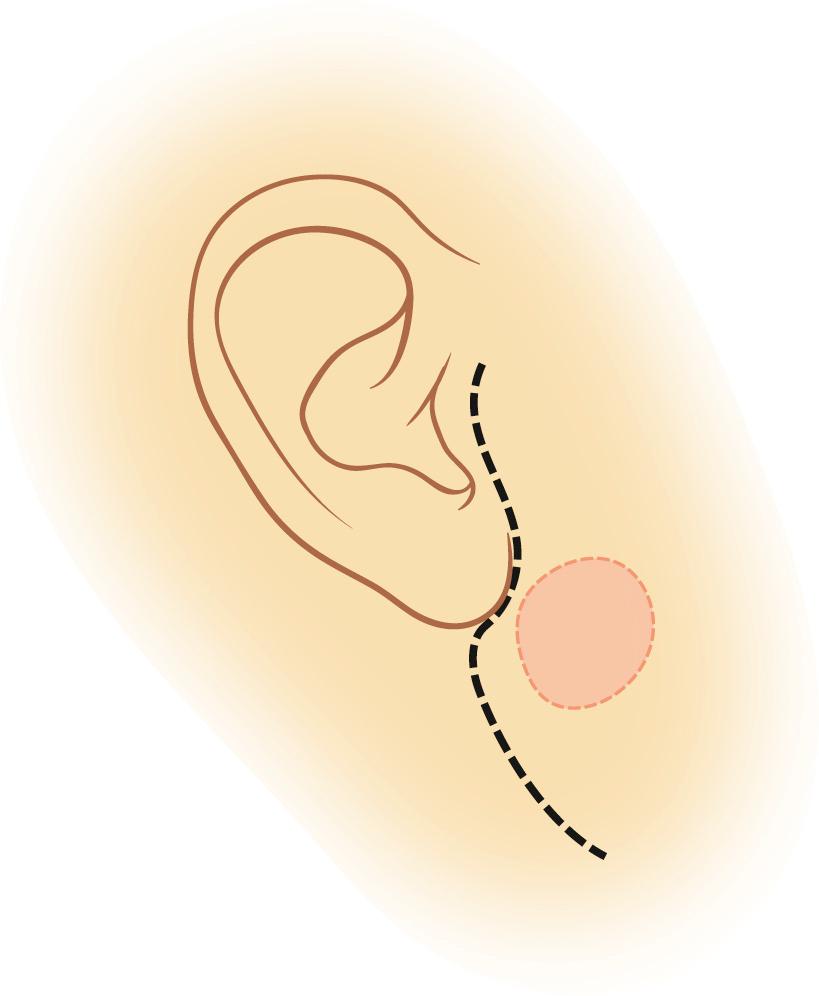
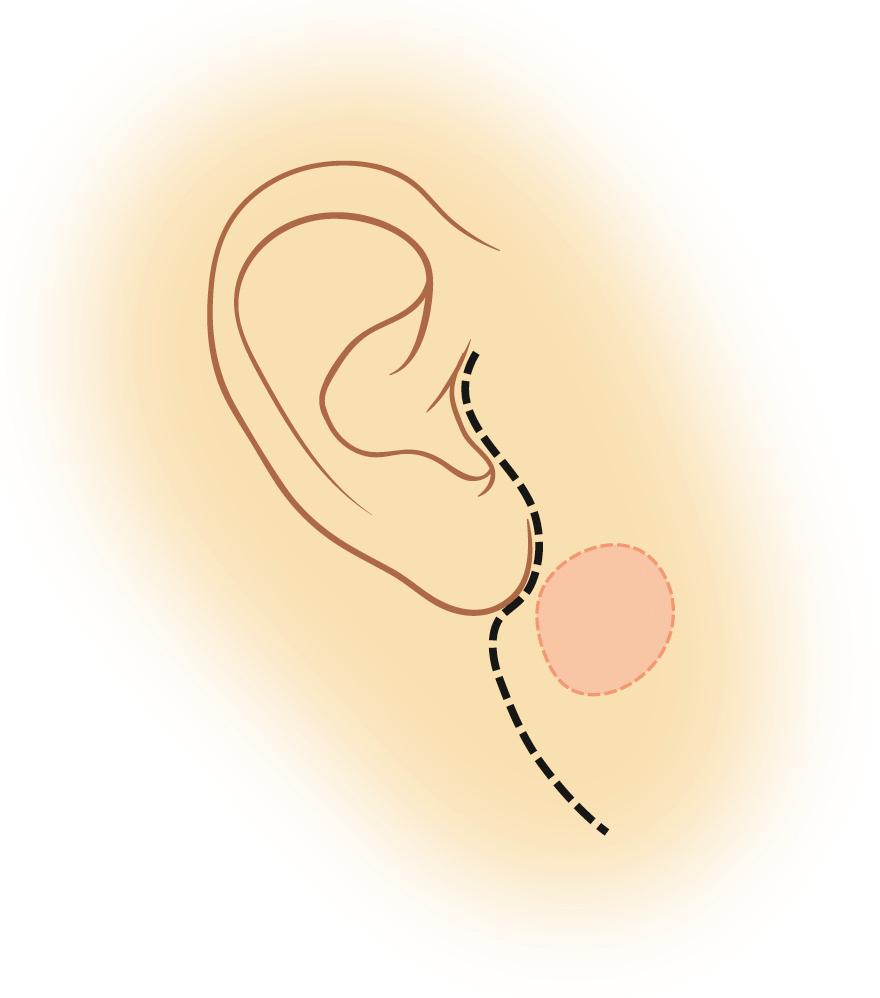
After the skin flap elevation is complete, the anatomic landmarks for identifying the main trunk of the facial nerve should be exposed. The fascia of the SCM is incised anteriorly, parallel to its anterior border, to dissect the muscle from the adjacent parotid tissue ( Fig. 35.1.3 ). In most patients, it is possible to preserve the posterior branches of the greater auricular nerve (GAN) without compromising the surgical exposure for resection ( Fig. 35.1.4 ). The anterior branch of the GAN may then be sharply divided. After dissecting the parotid tissue from the SCM, the posterior belly of the digastric muscle is displayed ( Fig. 35.1.5 ). Dissection between the auditory canal and the parotid gland is the final stage for dissection and identification of the main trunk of the facial nerve. Dissection of the facial nerve should be done with great caution to prevent injury. Blunt dissection is performed with a fine hemostat and careful use of the bipolar cautery to dissect the soft tissue superior to the posterior belly of the digastric muscle and its insertion into the mastoid process. Two right-angled retractors can be used to gently pull the parotid anteriorly ( Fig. 35.1.5 ). The main trunk of the facial nerve can be found in the area formed by the posterior belly of the digastric muscle, the anterior border of the mastoid tip, and the inferior border of the auditory canal. The dissection in this region is done using a long, curved hemostat along the direction of the nerve ( Fig. 35.1.6 ). This dissection must be done in small increments, with careful hemostasis.
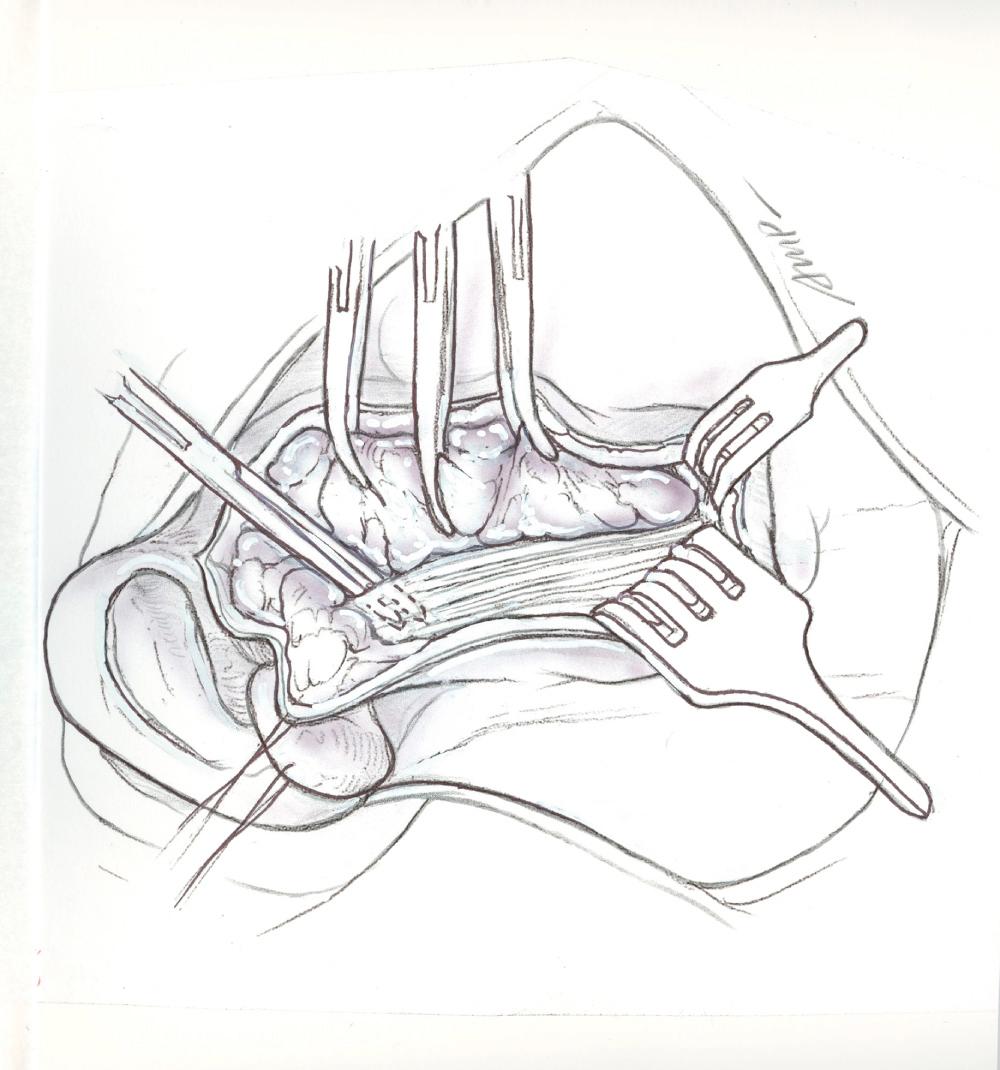
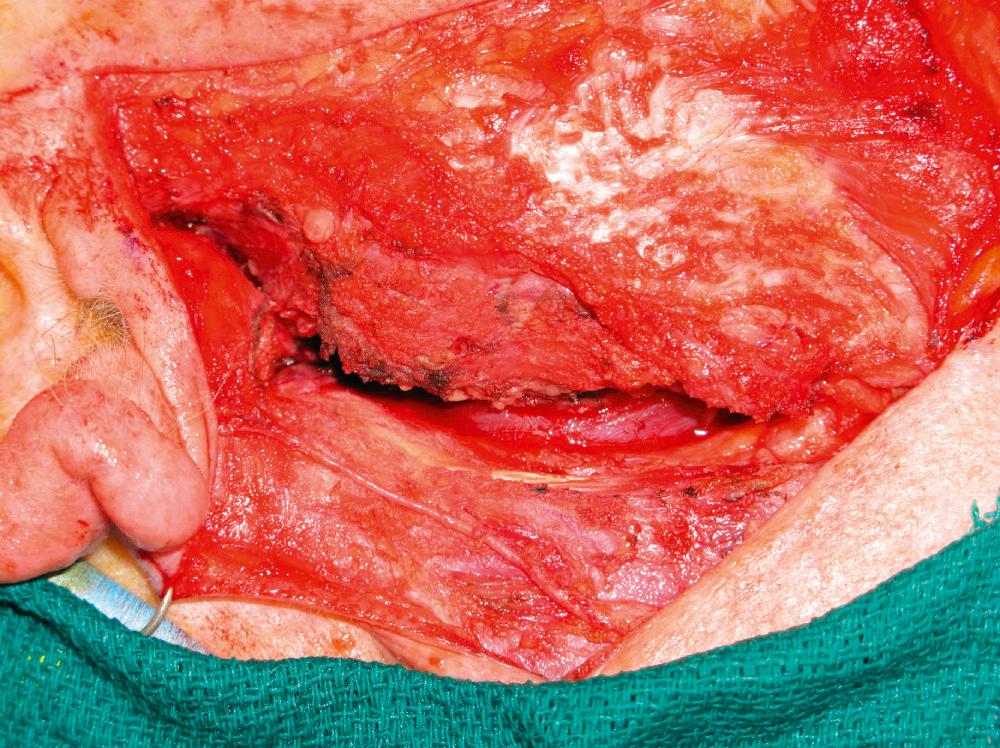
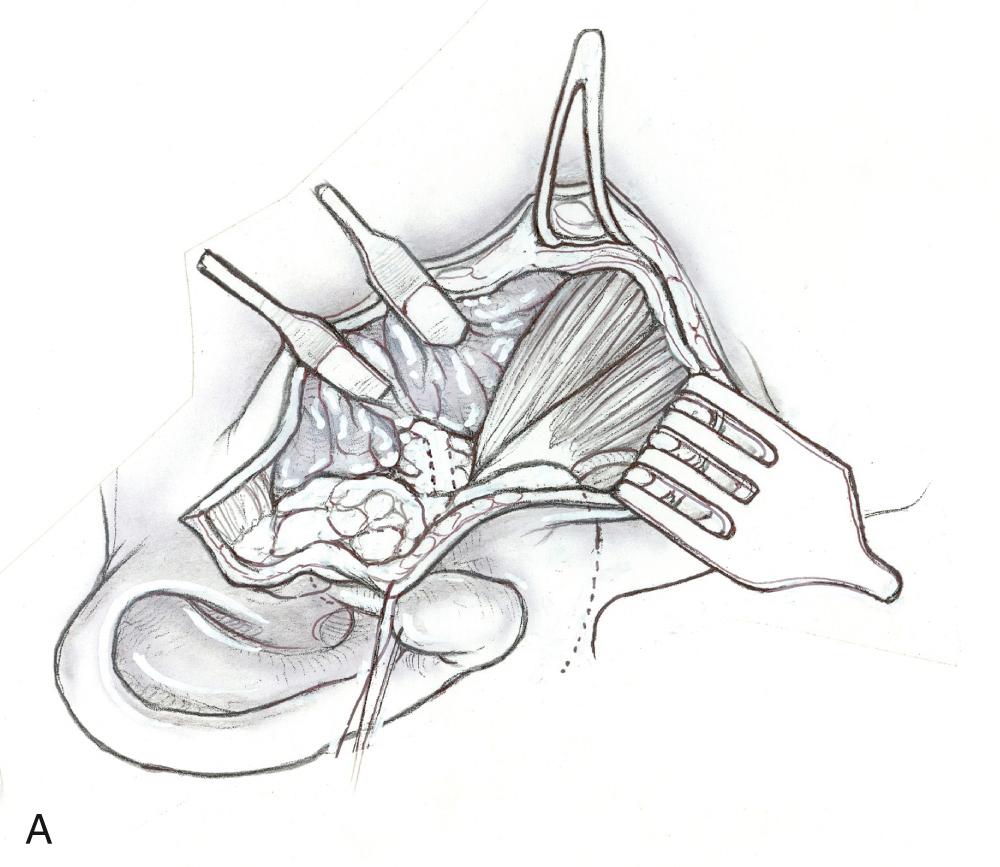
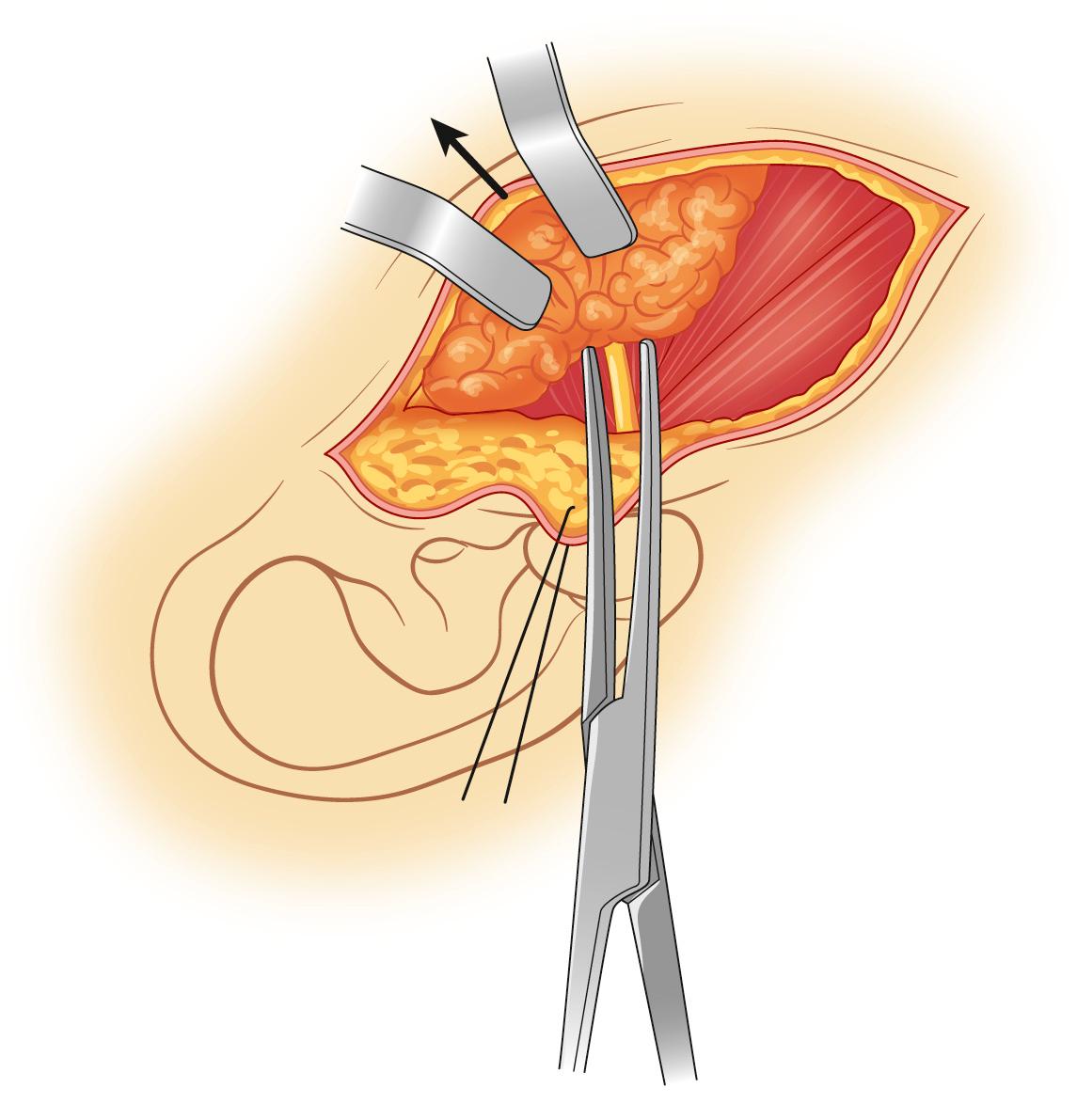
Another landmark for finding the facial nerve is the tympanomastoid suture (see Chapter 1 ). The tragal pointer is 1–2 cm from the facial nerve and this can change with retraction. Because the styloid process is deep to the facial nerve, using it as reference to identify the nerve can put this nerve at risk. Located 1–5 mm inferior to the facial nerve, the tympanomastoid suture is a fixed landmark, but is palpated and not visualized like the digastric muscle. The posterior belly of the digastric muscle's distance from the facial nerve, however, can vary from 0.5 to 1.5 cm.
The retrograde approach for identifying the facial nerve has high variability of the peripheral facial nerve branches compared with the main trunk of the nerve, which is the most consistent portion. This approach is useful in revision surgery, where there is scar tissue over the main trunk of the facial nerve. It is also helpful when bulky tumors impede the visualization of the main trunk of the facial nerve. The retromandibular vein is used as a reference to find the marginal mandibularis branch and the superficial temporalis veins for the temporalis branches of the facial nerve.
Once the facial nerve trunk has been identified, the operation continues with dissection of the branches and in the process, excision of the superficial lobe of the parotid gland with the tumor. During this phase, adequate exposure without exerting excessive traction on the nerve and hemostasis are essential. Trying to control bleeding without direct visualization of adjacent nerve increases the risk of nerve damage. A long, curved hemostat is used to follow the nerve direction. The hemostat navigates over the nerve, avoiding friction on the nerve, and its tip is lifted up to present the bridge of parotid tissue to be sharply divided ( Fig. 35.1.7 ). Large vessels are ligated with 4-0 Vicryl prior to dividing them and bleeding from smaller vessels is controlled with bipolar coagulation. The nerves run from deep to superficial, so the peripheral branches are at greater risk for injury. The Stensen's duct must be dissected free from any of the adjoining buccal branches, which course parallel to the duct. The duct is then ligated with 3-0 Vicryl and sharply divided ( Fig. 35.1.8 ).
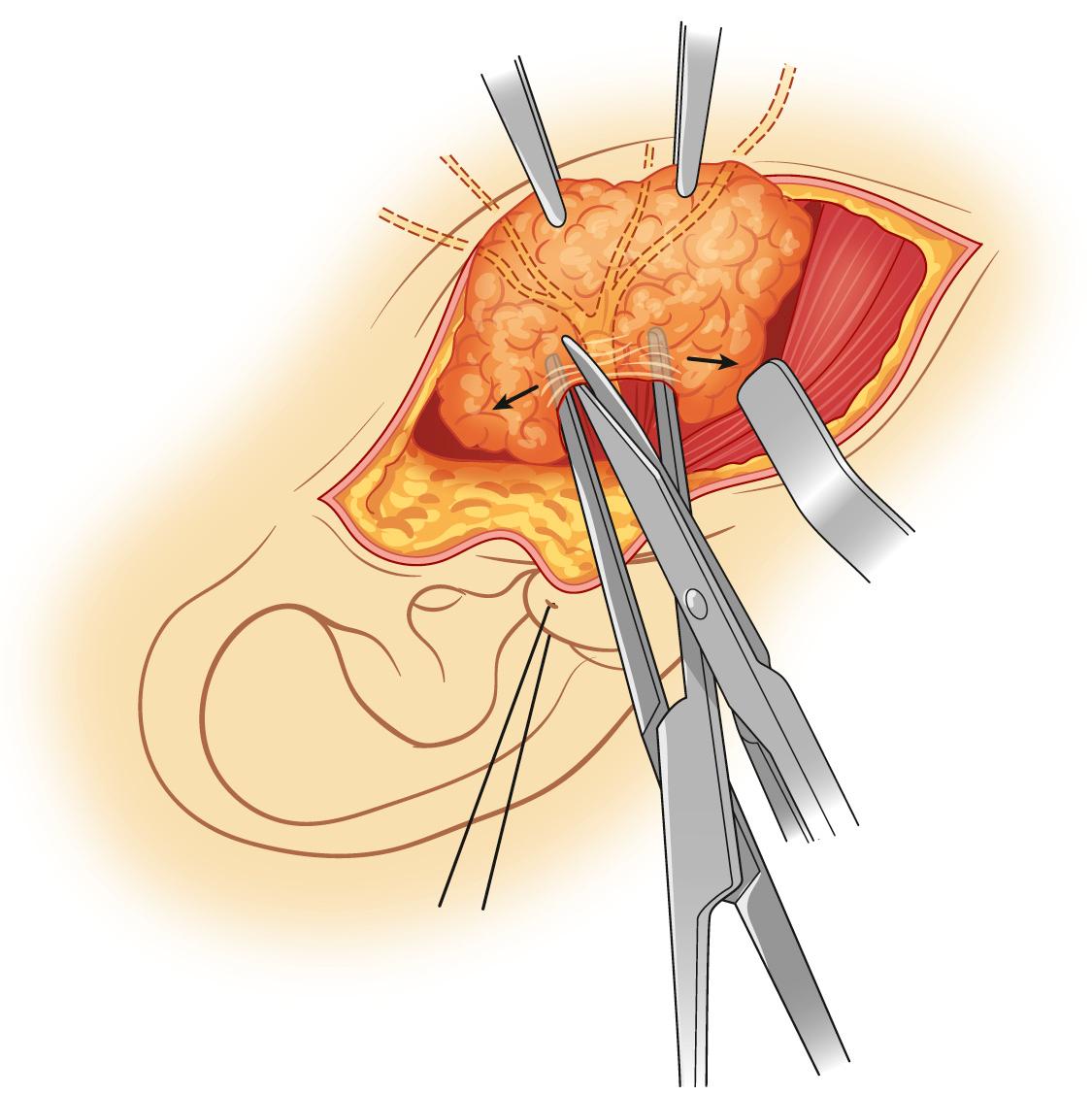
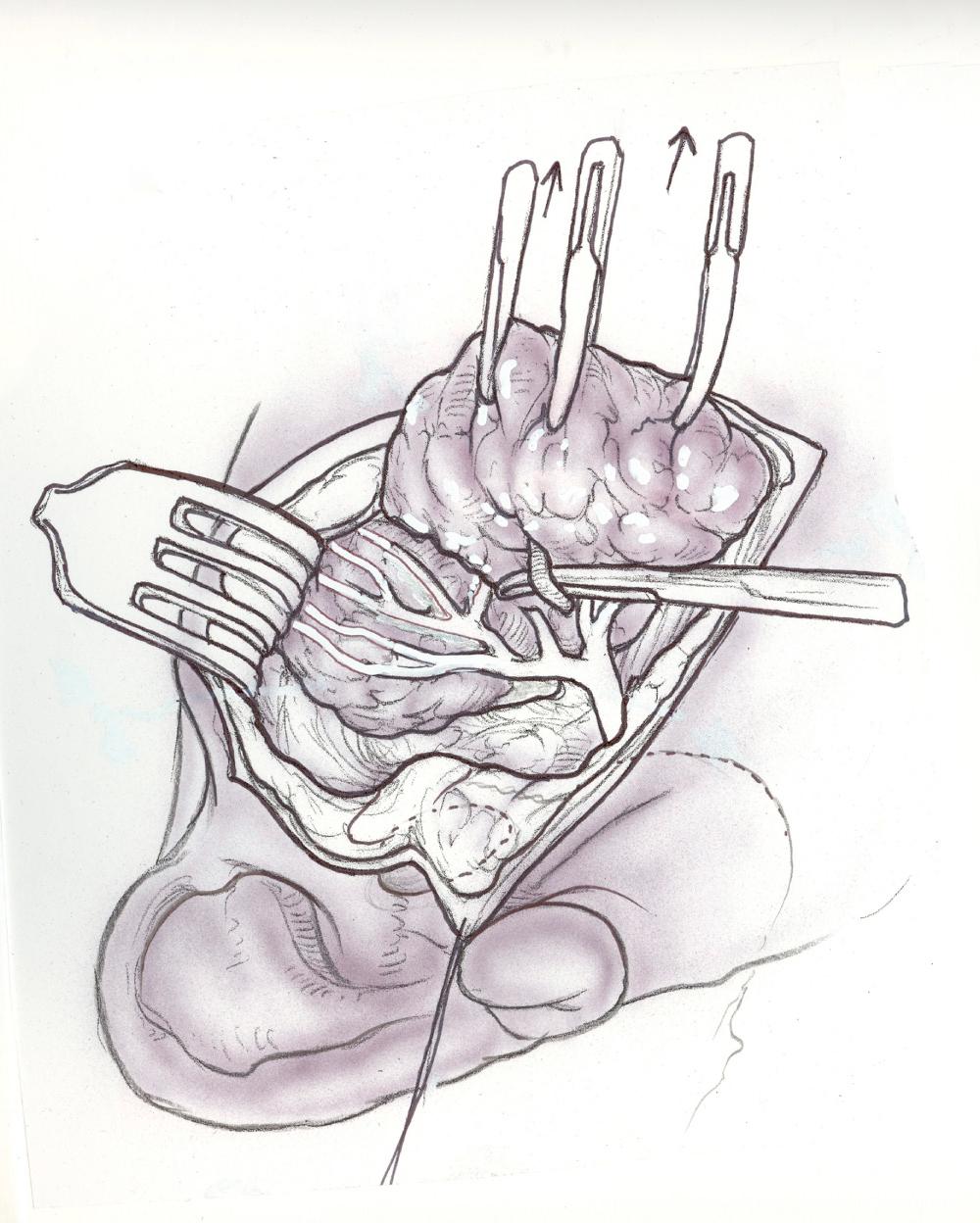
While the facial nerve and its branches are being dissected, absolute hemostasis is required. For that reason, the patient's systolic pressure should be kept around 90 mmHg and his/her position should be in reverse Trendelenburg. After the specimen has been delivered, it is important to reverse hypotension to secure hemostasis prior to closing the surgical wound. Drainage can be established either with Penrose or closed suction drain, as long as the suction drain tip is not in contact with the facial nerve. The wound is irrigated with warm saline and hemostasis is confirmed. The incision is then closed with one subcutaneous layer using interrupted, inverting 4-0 Vicryl sutures, followed by interrupted 5-0 nylon sutures or absorbable subcuticular 5-0 Monocryl suture to close the skin. Antibiotic ointment or Steri-Strips can be applied over the clean suture line. A light dressing is used to cover the Penrose drain, while the suction drain requires no dressing. The drain is removed as soon as the discharge tapers out, usually on the day following the operation. Some surgeons choose to use fibrin sealant without drains after parotidectomy. In these cases, it is important for the surgical site to be covered by a compressive dressing.
The most feared complication after a parotidectomy is facial paralysis or paresis. The management of this condition is discussed in Chapter 50 . Temporary facial paresis, most commonly functional deficit of the marginal mandibular branch, is not uncommon. It can be expected when the tumor is dissected off the nerve, but in many cases, it is not predictable. Recovery of function usually occurs within 3 months, when the nerve has not been injured during the surgery. (For other complications, see Chapter 39 .)
The parotid tumors that are medial to the plane of the facial nerve are rare. Only 20% of the parotid salivary tissue lies medial to the plane of the nerve, or in the “deep” lobe. Most of these tumors are benign and they can be located in the retromandibular area or in the parapharyngeal space. Radiologic imaging is extremely important, as it is very reliable in differential diagnosis. Therefore, histologic diagnosis is usually not necessary. Image-guided needle biopsy can be done by experienced hands, but open biopsy is not recommended.
Resection of tumors of the deep lobe of the parotid gland is accomplished after removing the superficial parotid lobe, as described above. The tumor is then dissected from the facial nerve branches using a fine hemostat, scissors, and fine-tipped bipolar coagulation. The tumor must be handled carefully to minimize the risk of rupture of its capsule. Because of greater manipulation of the facial nerve and its branches, the rate of transient nerve dysfunction is higher.
Most tumors of the deep lobe can be resected using the transcervical approach. An approach that involves a mandibulotomy to assess the deep lobe of the parotid gland is usually required for some malignant tumors, for tumors that are locally recurrent, or for previously violated surgical field by an attempted per oral resection. The mandibulotomy approach is further detailed in Chapter 47 .
Certain important technical details can help increase surgical exposure of the tumor of the deep lobe of the parotid. Using a nasotracheal tube provides a better excursion of the lower jaw, which improves accessibility for the tumor. Complete muscle relaxation after dissection of the facial nerve and superficial parotidectomy have been accomplished is very helpful. Other intraoperative maneuvers include lateral retraction of the angle of the mandible with a bone hook, division of the posterior belly of the digastric muscle and/or stylohyoid complex, and excision of the submandibular gland.
The operation starts with a superficial parotidectomy. After the superficial lobe is mobilized and the facial nerve is exposed, the tumor of the deep lobe should be visible underneath the facial nerve and its branches, which are typically stretched by the tumor ( Fig. 35.1.9 ). Using sharp, fine scissors and a nerve hook, the nerve and its branches are dissected off the underlying tumor. Digital dissection along the periphery of the tumor can be used to mobilize it towards the neck. The nerve is gently retracted cephalad and the fibrous bands are sharply divided during the digital dissection ( Fig. 35.1.10 ). This dissection must be very gentle to avoid trauma to the facial nerve and also to make sure all the tumor and its lobules are removed without rupture. After the tumor has been excised, the hemostasis, drainage, and incision closure is the same as described above for superficial parotidectomy.
Located 1–5 mm inferior to the facial nerve, the tympanomastoid suture is a fixed landmark but is palpated and not visualized like the digastric muscle.
Temporary paresis of the facial nerve can last up to 3 months.
Most tumors of the deep lobe can be resected using the transcervical approach.
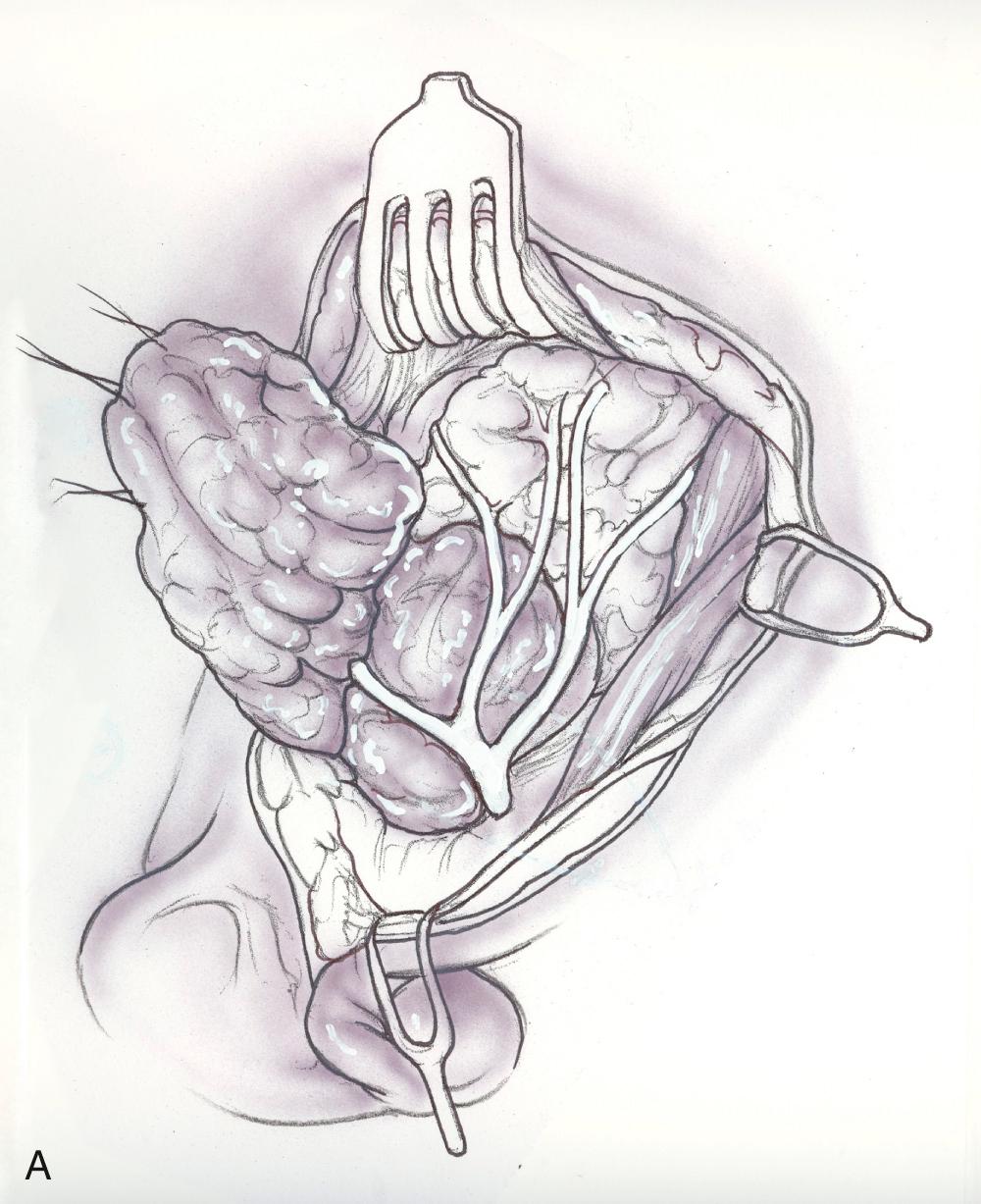
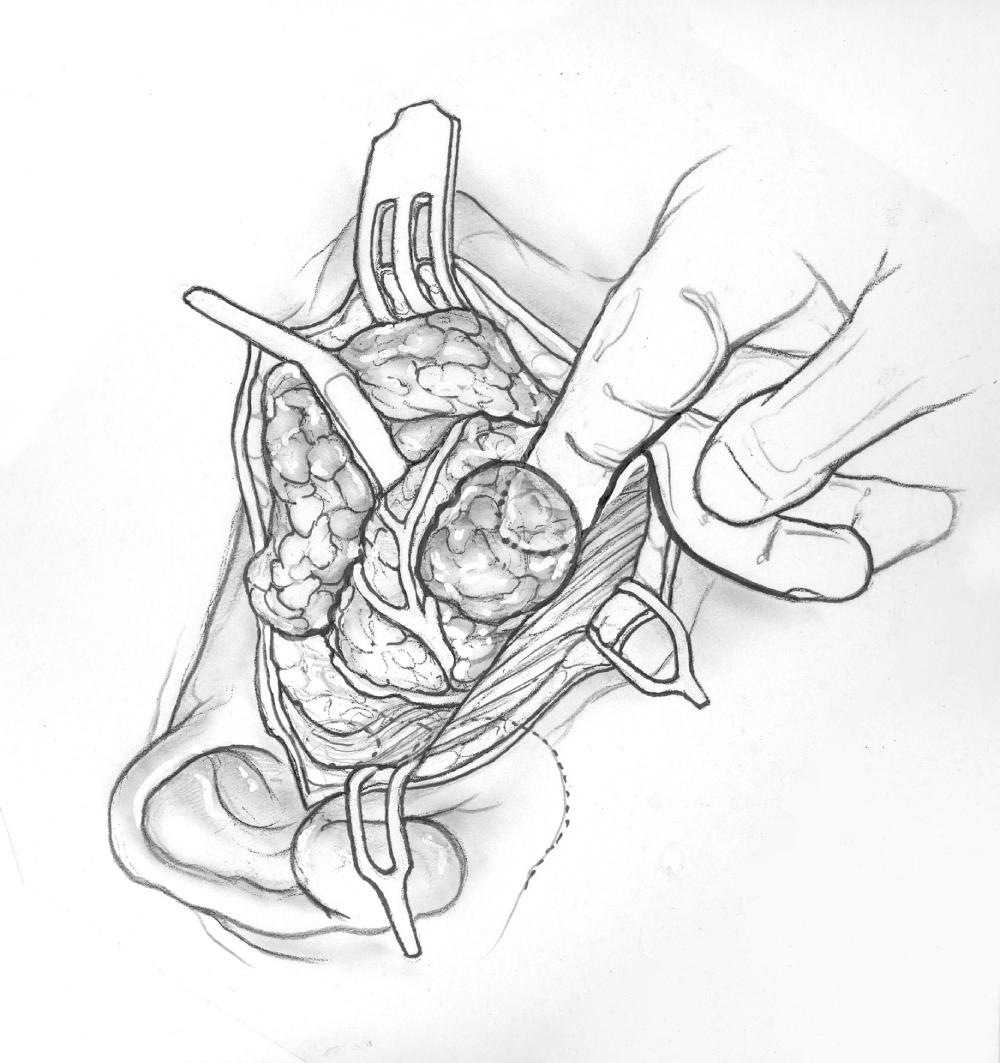
Facial nerve dissection for parotidectomy typically involves identification of the main trunk of the facial nerve just after it exits the stylomastoid foramen, within the parotid gland, then tracing the nerve to the pes anserinus and its superior and inferior divisions, and is known as antegrade facial nerve dissection (AFD).
Retrograde facial nerve dissection (RFD) involves identification of one or more distal branches of the facial nerve followed by dissection towards the pes and main trunk. RFD is beneficial in the setting of anterior lesions, in which the antegrade approach would require exposure of long segments of the facial nerve. Additionally, masses confined to the tail of the parotid often require identification of only the distal few branches in proximity to the mass to obtain an adequate margin of resection. RFD allows for ease of preservation of the superficial musculo-aponeurotic system (SMAS), GAN, and Stensen's duct. Finally, obese patients, in whom exposure of the main trunk may be more difficult, may benefit from RFD.
RFD encompasses two different techniques. The first involves identification of a single distal branch, following it back to other branches or the pes, and then tracing other branches in an antegrade fashion. Alternatively, all involved branches of the nerve are identified distally and exposed in a retrograde fashion only as proximally as is required for excision of the lesion. Often, only one or two branches require dissection in this method.
RFD is performed through infra-auricular and/or pre-auricular incision(s) tailored to the size and location of the parotid lesion. After superficial flaps are elevated over the SMAS, SMAS flaps are raised off of the parotid gland leaving an island of SMAS as margin on superficial masses as indicated; with exposure and preservation of the great auricular nerve posterior branches just deep to the posterior SMAS as needed. The distal branch(es) of the facial nerve are then identified optimally with the help of electromyography (EMG) monitoring of facial nerve branches. The two easiest distal nerve branches to identify are the ramus mandibularis or frontal. The ramus mandibularis branches are frequently multiple and within 10 mm posterior and inferior to the angle of the mandible and often superficial (but some branches may be deep) to the retromandibular vein ( Fig. 35.1.11 ). The frontal nerve branch passes over the middle portion of the zygomatic arch and is often palpable over the arch bony surface ( Figs. 35.1.11 , 35.1.12 ) and anterior to auricular muscle branches. The nerves are then traced in a retrograde manner only as proximally as is required to excise the mass.
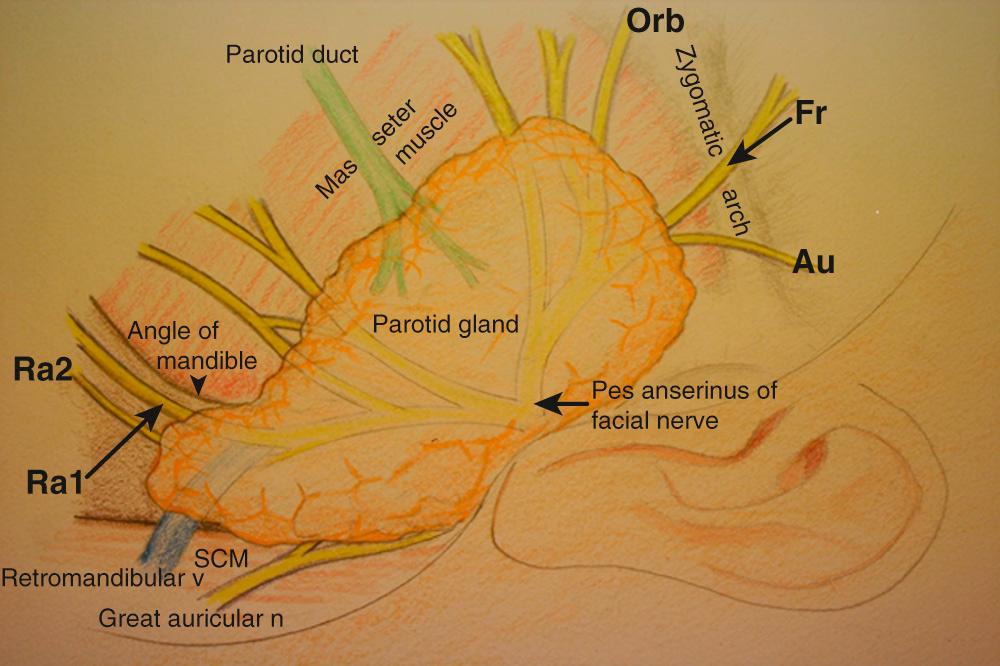
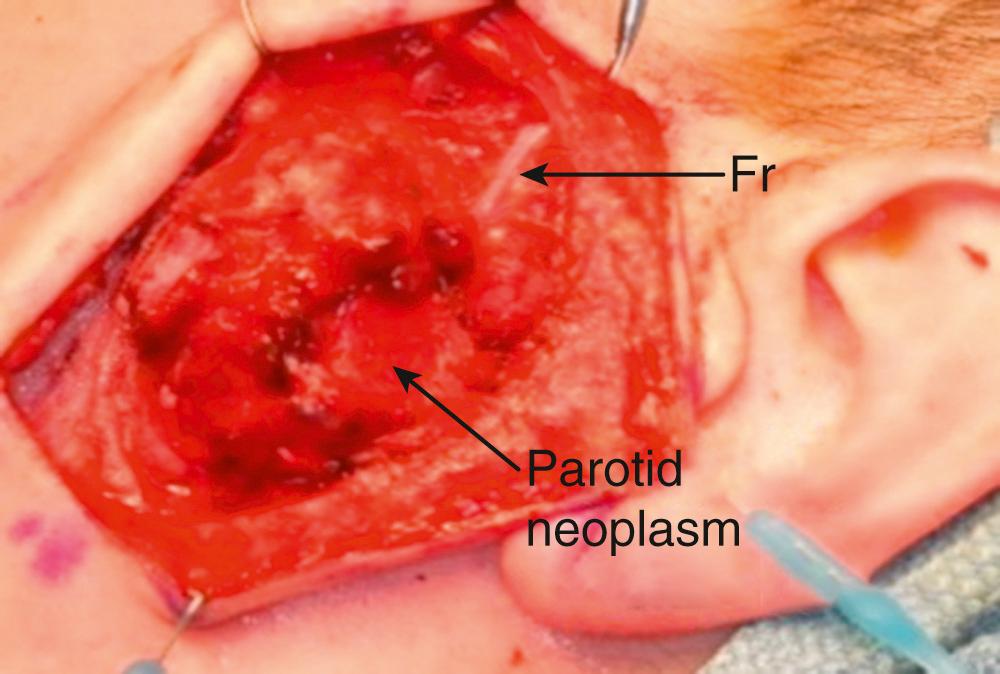
RFD also allows for more reliable preservation of the parotid duct. The duct is normally located in the region of the middle third of a line connecting the tragus to the midpoint of the upper lip vermilion border. After the distal facial nerve branches are located, the duct is found between the superior and inferior divisions of the facial nerve ( Figs. 35.1.11 , 35.1.13 ). The parotid duct may be mistaken for a large facial nerve branch (and does run parallel to the buccal branch), but unlike a distal facial nerve branch, it does not stimulate, nor does it taper or branch distally, while it does taper and branch abruptly into parotid tissue proximally. After exposing the involved nerve branches and the duct, the mass is excised ligating only the ductules draining the excised portion of the parotid gland.
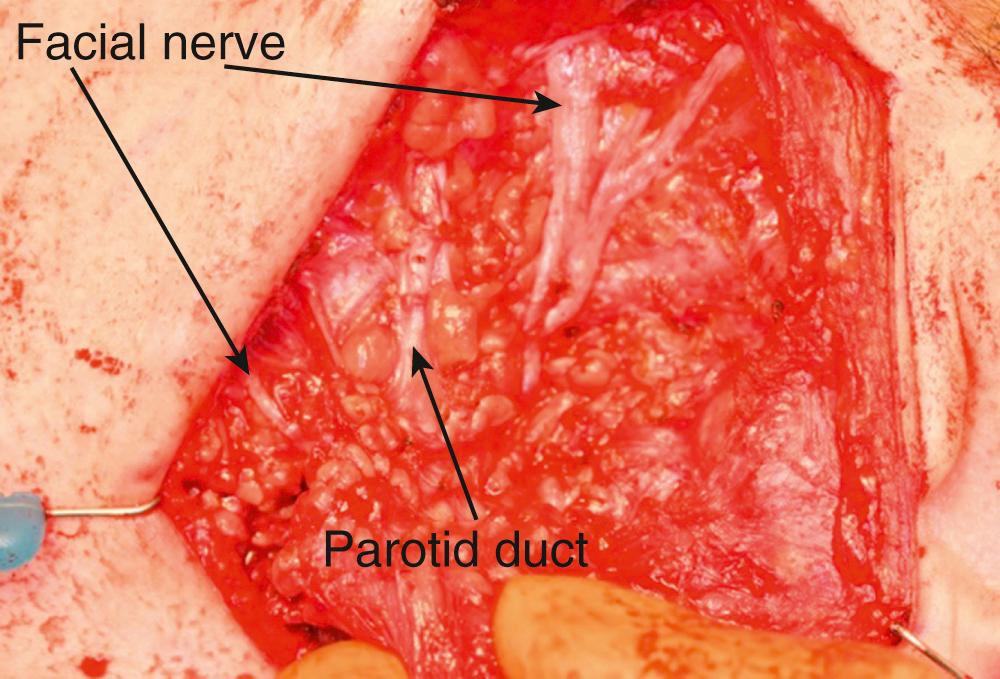
Meta-analysis has shown no statistically significant difference in temporary or permanent facial nerve weakness between AFD and RFD. Operative time was found to be significantly shorter in the RFD group. Preservation of ear lobule sensation (GAN branches) was statistically significantly improved in RFD, as was ductal preservation. The parotid surgeon should be facile in both antegrade and retrograde approaches to facial nerve dissection.
Become a Clinical Tree membership for Full access and enjoy Unlimited articles
If you are a member. Log in here